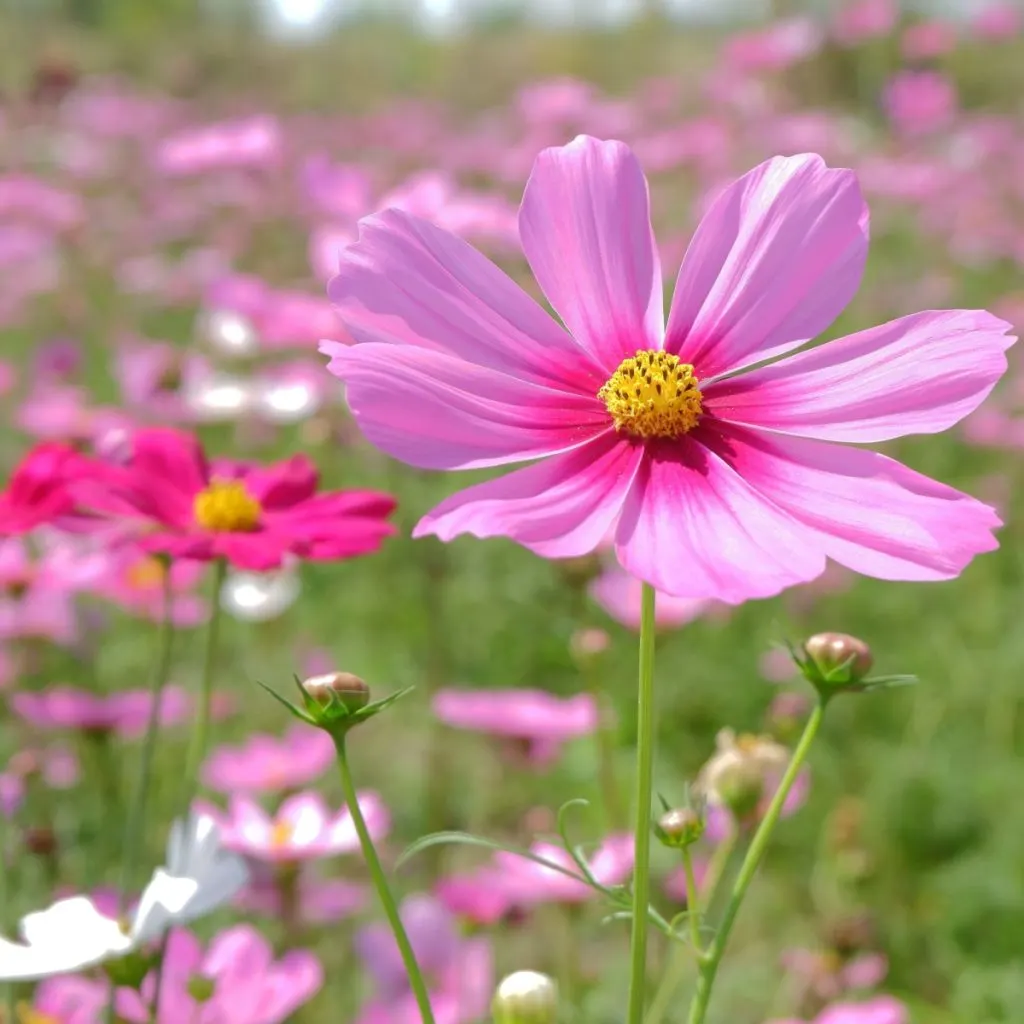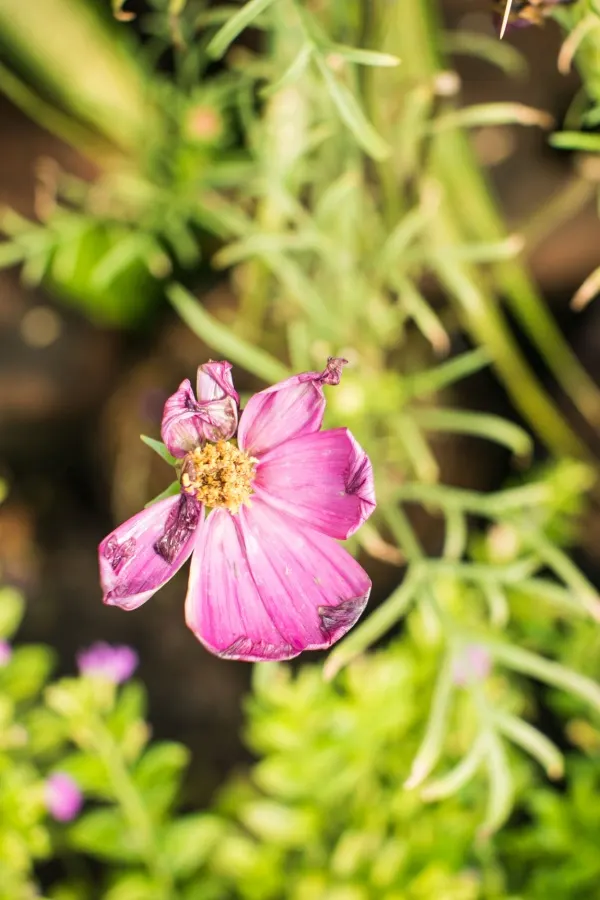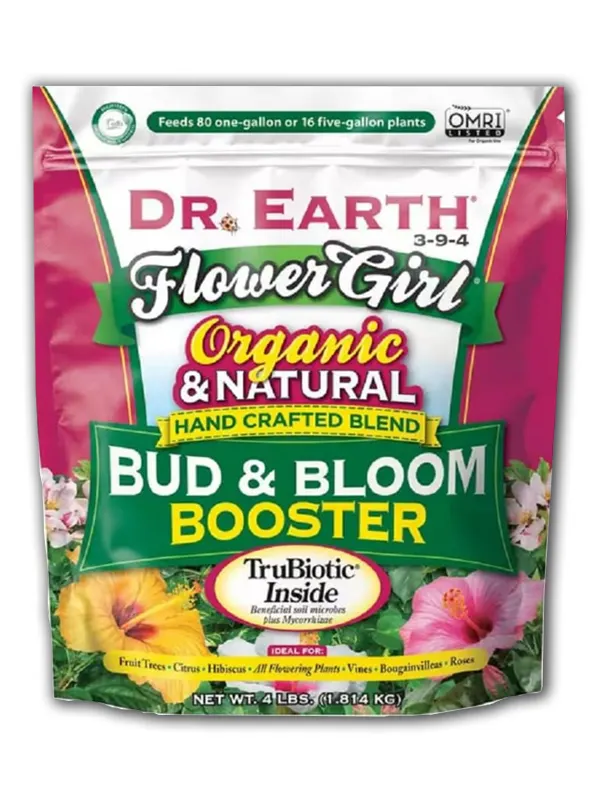Looking for a few simple tips and tricks to keep your cosmos blooming long and strong this summer?
Cosmos are the perfect flowering annual when you are looking for low-maintenance plants. While they take a bit of time to germinate, they are one of the easiest of all annuals to plant by seed. Even better, once they sprout, they mature and bloom fast!
With their dainty flowers atop fern-like foliage, they are perfect for drawing in loads of pollinators. Bees, butterflies, and even birds all love to visit cosmos daisy-like blooms. But in order to keep those blooms coming on strong, a few simple but key requirements need to be met for this flowering annual.

When it comes right down to it, there are three main things you need to do for cosmos to keep them flowering strong – deadheading, fertilizing and watering. With that in mind, here is a look at how do each of those three tasks to perfection – and get the most from your cosmos this year!
Three Simple Ways To Keep Cosmos Blooming Strong
Deadheading Spent Blooms
One of the most important ways of all to keep cosmos blooming from spring until fall is deadheading. This is the process of removing old and dying blooms from the plants.
Many annuals and perennials depend on deadheading in order to continue blooming all season long. Without it, the flowering plants will struggle to produce new blooms. And cosmos are no different!
As blooms begin to fade and die back, the plant continues to waste energy and nutrients trying to repair it. Unfortunately, no amount of nutrients or power will save them fading blooms. But instead of those resources being wasted, deadheading allows the plants to save that power and refocus it on producing new blooms.

For cosmos, simply take a pair of small pruners or even your fingernails and cut the spent blooms back to where the stem meets the rest of the foliage. Even leaving the stem behind will waste precious energy and nutrients.
Those cut blooms can be turned into beautiful arrangements and displays. So not only will your plants be stronger and healthier by deadheading, but you can still enjoy their beauty both outside and inside your home!
If you get behind with deadheading, you can always simply cut back about a third of the plant after most of the blooms are done. This will help to encourage a second blooming during the same growing season.

Boosting Blooms – How To Keep Cosmos Blooming
Although cosmos can survive without fertilizing, giving them a little extra power can help prolong and improve their blooming. The key with this however is to use the right type of fertilizer to avoid over-fertilizing with the wrong nutrients.
Cosmos do not handle high amounts of nitrogen well. While it is great for filling out foliage on plants, excess nitrogen can actually cause cosmos to stop blooming. Instead, it’s important to utilize a fertilizer with higher levels of phosphorous and potassium, which happen to be two nutrients that help cosmos bloom better than ever.
Phosphorous helps cosmos plants to grow strong roots, push out new blooms, and maintain their flowers. Potassium, meanwhile, helps provide energy and protection for the overall heath of cosmos plants and blooms.
What To Use And When – How To Keep Cosmos Blooming
Commercial fertilizers list nutrients with an N-P-K ratio. The “N” stands for Nitrogen, “P” for Phosphorous, and “K” for Potassium. For cosmos, you need a lower number of nitrogen and higher numbers of phosphorous and potassium. Product Link: Dr. Earth Bud & Bloom Fertilizer
You can use either liquid or granule fertilizers with cosmos. The biggest key with either is to simply not over fertilize but instead provide gentle power. Mix the minimum amount of granular fertilizers into the soil or use liquid fertilizers at half the recommended dose.
For cosmos growing in containers, fertilize with a low dose about once a month. This helps replenish the limited number of nutrients within container soils. For cosmos growing in the ground, fertilize at planting and once after a month.
Anything more than this can cause the plants to actually bloom less. And with no fertilizer at all, they simply don’t have enough to reach their maximum blooming potential. A little goes a long way with cosmos!
How To Water Cosmos – How To Keep Cosmos Blooming
As mentioned earlier, cosmos are extremely drought resistant and heat tolerant. The seeds require plenty of moisture to germinate, but mature plants are able to handle all but long periods of drought.
However, while the plants might survive tough, dry conditions, it doesn’t mean they will thrive with blooms. This is exactly why giving your cosmos proper moisture is another big key for better blooming. But how and when you water matter greatly.
Allow the soil to completely dry out in between watering. This goes for plants grown in containers or those in the soil. When it’s time to water plants, do so deeply as opposed to small amounts more often.
Avoid overwatering as this can be as much of an issue with cosmos as underwatering. Using mulch around the base of plants can help to retain moisture and prolong the time between waterings even more.
One last tip with watering – avoid using city water or water that has been treated. The salts and chemicals in the water can affect the plant and its blooming potential quite easily.
Here’s to providing cosmos with just what they need to enjoy their beautiful blooms all growing season long! For more on keeping flowering annuals blooming, check out our article on deadheading zinnias : How To Deadhead Zinnias – And Keep Them Blooming All Summer Long!
Simple Garden Life
Follow Our Facebook Page For Even More Great Tips! Simple Garden Life Facebook Page
Simple Garden Life is a website dedicated to keeping gardening fun, simple and enjoyable! We publish two new articles each week along with a new garden podcast episode every two weeks. This article may contain affiliate links.

